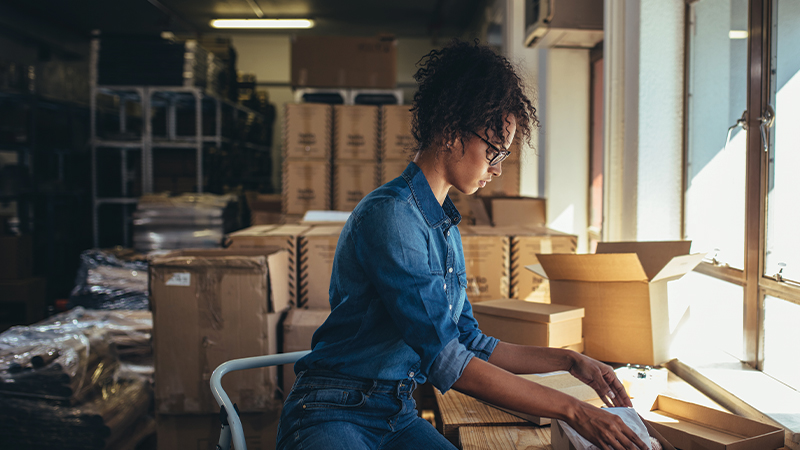Grow your business with the Discover newsletter
Logistics advice & insights straight to your inbox
Subscribe now
B2B e-commerce is growing – and fast. Many traditional B2B processes – from sales to customer interactions; from fulfillment to delivery – have moved online, a change that was always coming, but was hugely accelerated as a result of the Covid pandemic. In fact, so significant was the shift, that three years ago we published an exclusive white paper on the B2B “revolution.”
So, where do things sit now? To find out, we spoke to Alex Weston, Sales Director, and Neil Kuschel, Non-executive Director of SparkLayer, an all-in-one platform which transforms clients’ existing Shopify stores into fully featured B2B solutions.
At the forefront of wholesale and B2B retail, they have seen buyers’ preferences shift considerably in recent times. “Where historically procurement has involved putting in an order on a spreadsheet, buyers don’t want that anymore,” Neil explains. “They want to be able to browse and order online – from multiple sources – seamlessly. They don’t want to have to speak to someone, they want to be able to log in and see what they’ve ordered in the past, see the correct pricing and delivery options.”
Just as B2B buyers’ demands have shifted, so too have the priorities of the sellers themselves. Alex points to the wave of direct-to-consumer brands which flourished during the pandemic’s online shopping boom but have since seen their sales slow. “They’re now wondering where their next level of growth comes from and know they need to be able to acquire customers in different ways to diversify their sales channels.”
Yet the problem, says Neil, is that whilst a B2C retailer may be aware that they should optimize their platform to attract B2B wholesale buyers, “they don’t quite know where to begin.”
And that is exactly the problem SparkLayer is working to solve. It helps merchants selling online to add B2B functionality to their existing or Shopify website, simply and quickly.
“Most [B2B buyers] desire the ability for the vendor to order on their behalf, custom pricing, and a user-friendly platform that allows quick order creation and replication.”

“One of the core principles of SparkLayer is that the B2B experience should be very, very similar to the B2C experience,” says Alex.
This informs many of the platform’s key functionalities. It has ready-made B2B-optimized frontend "widgets" that simply replace sections of client’s existing e-commerce stores. They’re designed to make ordering simple and account management as "self-service" as possible for buyers – for example, allowing them to duplicate orders in a single click, and checkout using saved addresses and agreed payment terms.
For vendors, the platform is fully customizable; they can offer dynamic discounting and configure pricing rules on a per-customer basis – often one of the most complex areas when adapting B2B sales to accommodate a B2C mindset.
90% of buyers expect a direct-to-consumer-like experience on a B2B site, whilst 53% of B2B businesses have switched suppliers due to a poor buying experience.
- Wunderman Thompson research1

So, what of the future of B2B e-commerce? Will traditional sales methods be completely banished in favor of online? Maybe not…
“I saw one of our biggest customers a couple of weeks ago,” Alex recalls. “They still have a salesperson who’s out on the road and takes boxes of biscuits to the client, because if they don’t do that, their competitors will. They still print off a catalog so that they can take that with them as well. This hybrid and blended approach means that the two things coexist rather than sit separately.”
Naturally, Alex highlights negotiation too, which has always been a key component of B2B sales and traditionally performed face to face.
“[Now with online,] it means that whoever is doing the negotiation and wherever they end up with a final price list, that price list needs to be uploadable. So, B2B vendors can manage their price list and the customer agreement in the SparkLayer dashboard and then the scripts that they add to their website are basically looking for that particular customer and then sharing the relevant price with them when they’re logged in.”
Both Alex and Neil highlight the growth of cross-border B2B e-commerce, which is attractive to established retailers looking for scalability. But they also talk about the “accidental exporter” – successful D2C businesses which didn’t intend to sell internationally but received enquiries from buyers abroad.
Understandably, shipping is a big concern for such businesses. SparkLayer integrates with DHL’s international shipping tools on Shopify and other CMSs, helping vendors to deliver quickly to customers across the world.
“As globalization dominates and procurers realize they have multiple places that they can buy from, unless you make that journey the way buyers want it to be, you're going to start to lose sales.”
A final key piece of advice from the SparkLayer team is to invest in onboarding. “There’s a common misconception that you can just add a B2B component to your website and the buyers will come. But it doesn't work like that,” Alex explains.
“As the seller, you need to onboard your buyer; show them how it works, walk them through their first order. And then once they’re in the cycle of repeat and subscription ordering, they’ll be very loyal customers because they don’t want to change.”
Perhaps it’s appropriate to end with a positive tip from Neil: “B2B doesn’t have to be hard!”
Feeling inspired to add B2B to your sales channels? Discover the full benefits of SparkLayer, here.
With a DHL Express Business Account, you’ll receive international shipping guidance from the experts to support your B2B cross-border ambitions.